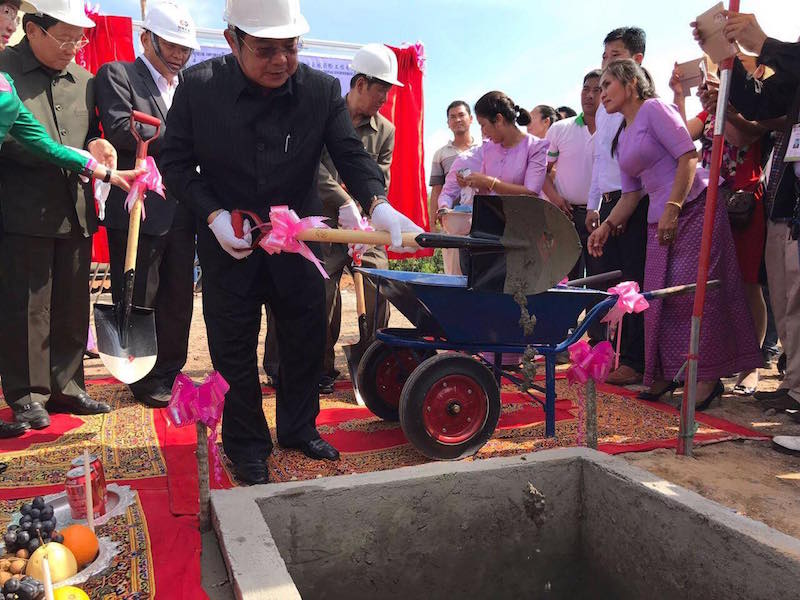On the top floor of an office building in Phnom Penh’s Tuol Kok district, next to an abandoned lot overgrown with grass, three board members of the Cambodian Petrochemical Company (CPC) laid out their plan to build Cambodia’s first oil refinery, in Preah Sihanouk province.
Throughout the hourlong conversation, it became clear the CPC so far has a relatively small financial role in the $1.6 billion project. Chinese companies have borne the brunt of the financial burden, according to CPC chairman Vinh Huor, one of the board members. The trio extolled the project’s potential benefits, including the creation of as many as tens of thousands of related jobs locally.

The three men are all oknhas, a royal designation meaning they donated large sums to the government for charitable purposes—the threshold was previously $100,000; it was recently raised to $500,000. They declined to name the CPC’s financial backers.
Chinese companies will be providing the funding, construction and installation of the refinery and its machinery, according to Mr. Huor. He also said CPC may end up selling 100 percent of its ownership stake to a foreign- or Cambodian-owned company.
CPC’s own investment has been to purchase the 365-hectare plot of land in Preah Sihanouk province where the refinery is set to be built, Mr. Huor said.
The $620 million price tag for the construction of phase one is being funded solely by a Chinese-listed construction company, Sino Great Wall International Engineering Co., and is backed by a loan from China’s state-run Export-Import Bank of China (EximBank), according to Mr. Huor.
“This company [Sino Great Wall] has the funds…. They do the construction for us,” Mr. Huor said. “Within this two years, they will finish building this factory and hand it over to us. Therefore, during the construction, we have not touched the EximBank funds yet.”
Before Sino Great Wall hands over the refinery, the Cambodian company will have to come up with $620 million. EximBank has agreed to provide the funding if necessary. However, the board members of the CPC hope to raise money themselves before accepting EximBank’s loan, Mr. Huor said, which could be achieved by selling ownership of the project to foreign entities.
“I could not tell you” who will own the company once the refinery comes online in two years, he said. “Right now it belongs to [the CPC] 100 percent.” However, that could change if an outside company made an offer, he said.
“If Chevron wants to buy it, and they come sit and talk…and the agreement of the price is reached, than we’ll sell it.”
In addition to construction, the installation of the refinery’s machinery will be carried out by a Chinese company, state-run oil giant China National Petroleum Corporation (CNPC), according to Mines and Energy Minister Suy Sem’s speech at the refinery’s groundbreaking on Thursday.
Cambodia will still benefit from the project, regardless of Chinese involvement in the early stages and the possibility of foreign ownership after completion, according to CPC and government officials.
First, both the CPC and the Mines and Energy Ministry touted the refinery’s ability to supply domestic demand, estimated by the ministry to be 1.8 million tons of fuel in 2015. The first phase of the project is projected to refine 2 million tons annually after its completion in 2019.
CPC representatives said that while fulfilling domestic demand was the plan, there was no law or company policy compelling them to do so.
“The government doesn’t force that [the refined product] has to be supplied domestically first,” Mr. Huor said.
Sy Meng Kheang, another CPC board member who spoke with reporters, acknowledged that nothing forced the company to supply domestic demand, but said the CPC planned to cater to the Cambodian market.
“I guess there is no such a law…whether or not we have to fulfill demand in Cambodia before we can export,” Mr. Meng Kheang said. “But in our plan, we plan to fulfill domestically first.”
Another potential boon for Cambodia would be jobs at the refinery, which the third board member, CPC director Hann Khieng, estimated could number in the thousands for skilled laborers and the tens of thousands in related industries.
The business potential of the refinery may be complicated by a region-wide boom of new refineries in recent years, combined with slowing demand from the region’s largest consumer, China, resulting in a glut of refining capacity and refined products.
Last month, The Wall Street Journal reported that the combination posed a threat to the billions of dollars already invested in refining operations in Asia. Analysts expected the surplus to continue to at least 2021, the Journal reported.
Nelson Wang, an energy analyst at CLSA in Hong Kong, told the newspaper, “We really don’t need one more giant refining complex” in Asia, while another analyst said there were already high levels of competition in the market. The state-run China Daily reported in September that China’s oil refineries were operating at below 70 percent capacity due to an oversupply in petroleum products.
CPC officials said they believed Asean’s tariff-free marketplace and the Cambodian refinery’s capacity to produce Euro-5 grade refined oil—oil of a higher grade that meets E.U. standards, which not many refineries in the region can produce, according to Mr. Khieng—would ensure its success
“We have no worry at all for the market,” Mr. Khieng said.



